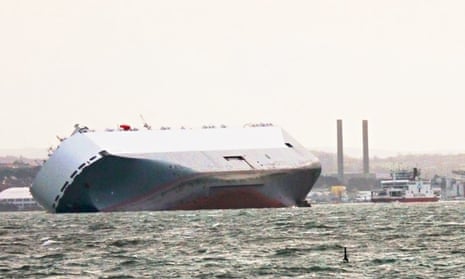Salvage experts are working out what to do next about a huge car carrier that unexpectedly refloated itself after being beached on a sandbank just off Southampton.
Plans to deliberately refloat the 51,000-ton Hoegh Osaka were abandoned on Wednesday because the vessel was considered to have taken on too much water.
But on high tide the ship refloated of its own accord and briefly threatened to drift into shipping lanes before it was brought under control and towed to a place of safety.
The ship is now at rest close to an area called Spitbank within the control of the neighbouring Portsmouth harbour master. An exclusion zone has been established around the ship and the salvors, coastguard, owners and other officials will work out what to do next.
A Marine and Coastguard Agency spokesman said the vessel refloated at high water and was towed by two tugs to a “holding position” pending a “full assessment”. “A decision on the next phase of the salvage operation will be made after the assessment,” the spokesman said.
“Queen’s harbour master Portsmouth has established a temporary exclusion zone of 300 metres around the vessel. Only exempt vessels are to enter the exclusion zone. The new holding position will allow a full assessment of her condition.”
The vessel, carrying a cargo of cars and construction equipment, began to list as it left Southampton port on Saturday, forcing the captain and pilot to take the emergency action of beaching it on the Bramble Bank sandbank to prevent it from capsizing.
Its cargo includes 1,200 Jaguar and Land Rover vehicles, 65 Mini cars and 105 pieces of JCB construction equipment. A major rescue operation resulted in 24 crew members and a pilot taken to safety by coastguard helicopter and RNLI lifeboats. Two people were taken to hospital with non-life-threatening injuries.
Initially, the idea on Wednesday had been to deliberately refloat the ship because it was feared it could sustain further damage if it remained on the sandbank, where it was resting lightly and was likely to be battered by the bad weather currently hitting the UK.
This scheme was abandoned because it was felt there was not enough time to clear water from the ship and instead the plan was to anchor the vessel down and refloat it on a future date. But the high tide and gusting winds caused the vessel to refloat itself. Officials said the boat was out of control briefly until it was stabilised and towed to safety.
The ship is currently being held steady by three tugs.
A spokesman for Hoegh Autoliners, which owns the ship, said the first step would be for divers to carry out a survey of the hull to inspect for damage, especially to the bilge keel which stops the ship from rolling.
The salvors will also prioritise the pumping off of water which was taken on board when an excavator in the cargo hold shifted and punched a hole in the hull on the sixth deck, which has since been repaired.
He added that surveyors would also attempt to reach the lower decks to inspect the integrity of the hull and check for any further damage. The cargo will be assessed to ensure it has not shifted or come loose, which could cause further problems when the vessel is re-righted.
The spokesman said the operation would be in “slow time” because of worsening weather conditions and could take “days or weeks”.
He said: “The weather is due to get worse and certainly over the weekend it will be quite choppy so the work will be carried out very slowly and carefully.
“The salvors are world-class and they will work as fast or as slow as they like as long as they are taking everything into account, being sensible and methodical in the conditions that they face.
“The vessel is listing at 52 degrees and to get fairly cumbersome equipment down the stairwells, which are at a very strange angle, requires super-human capacity. We just assume that they can do this and they have to take health and safety into account. You have to take it really, really slow.”

Comments (…)
Sign in or create your Guardian account to join the discussion